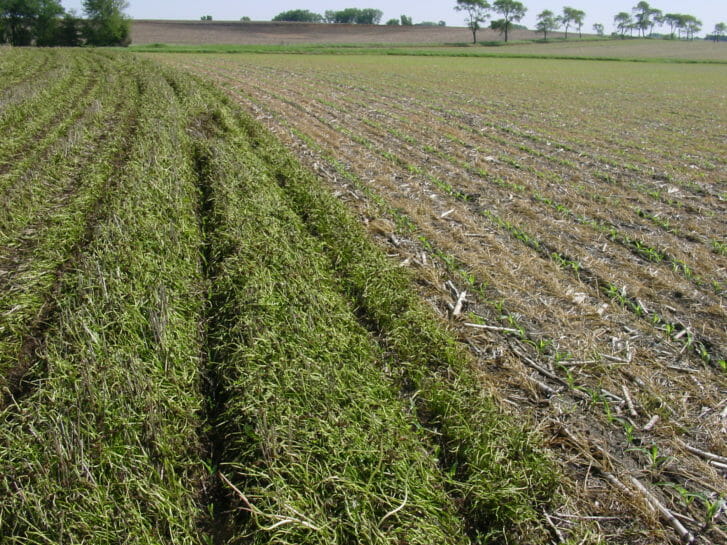RESEARCH REPORT: Timing of N Supply to Corn from Spring Terminated Red Clover
Cultivation of cereal rye for cover crop seed offers the possibility of frost-seeding a legume into the standing rye crop in early spring, where the legume can produce biomass and fix N following rye harvest. In 2014, farmer-cooperators Tim Sieren and Dick Sloan grew corn in rotation following cereal rye frost-seeded with red clover and compared this to corn grown using synthetic N fertilizer applications. Tim and Dick invited Iowa State University graduate student Will Osterholz on to their farms to quantify N uptake by corn as well as two measures of N release from soil organic matter: net N mineralization and gross ammonification.
This project measured soil N availability in the corn year of the rotations and sought to determine when in the growing season N is cycling from the red clover. The results can be found in a new report: Timing of N Supply to Corn from Spring Terminated Red Clover.

Corn emerges through desiccated red clover (on left) and the synthetic N treatment at Dick Sloan’s farm.
Among the Key Findings:
- Red clover did not improve corn growth, N content or grain yield compared to synthetic N fertilizer.
- Soil N mineralization rates in August tended to be higher with red clover compared to synthetic N fertilizer, but differences were not statistically different.
- Fertilization with supplemental N at planting could provide corn with early season N before clover decomposition can provide sufficient N to the corn crop in late summer.
Between the August and October/November sampling dates, the corn plants in the red clover treatment gained more N than the corn plants in the synthetic N treatment at both farms. These results do suggest that any reductions in yield in the corn following red clover are not due to lack of soil N later in the summer. Rather, N limitation likely occurs early in the growing season before the decomposition of the clover biomass can release substantial plant available N. Management that attempts to address early season N limitation following spring-killed red clover may help overcome the corn yield hit observed in these on-farm trials.
Read all about it here: Timing of N Supply to Corn from Spring Terminated Red Clover.
The results presented here supplement those found in previous research reports:
Corn Following Green Manure Cover Crops Established with Small Grain
Nitrogen Replacement Value of Red Clover
This present project is supported in part by the Sustainable Agriculture Research Education program (which is funded by the U.S. Department of Agriculture- National Institute of Food and Agriculture); the Leopold Center for Sustainable Agriculture; Walton Family Foundation and the Iowa Department of Agriculture and Land Stewardship, Division of Soil Conservation.
For more information about this study and other studies as part of PFI’s Cooperators’ Program, contact Stefan Gailans at stefan@practical farmers.org.
